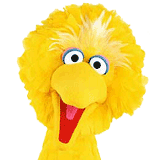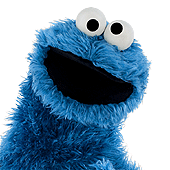I know no one cares about this thread anymore, but for some reason this is a topic my brain keeps coming back to. So i'm going to write this timeline for my own sake:
Season 1 The beginning of the Expiriment: The human characters, Gordon, Bob, Susan, and Mr. Hooper, are the main characters, with Gordon acting as a host, a bit like a more hip Mr. Rogers. Most street scenes don't have a story, they usually consist of one of the human cast giving a lecture about the letter or number of the day, or interacting with/discussing a real animal, from zoos and shelters. These animals included raccoons, or turtles, monkeys, etc. The only Muppet characters that appeared on the street with the humans were Big Bird and Oscar, and they rarely appeared in more than one or two scenes per episode. The rest of the Muppets including Kermit the Frog, Ernie and Bert, singing Anything Muppets, and scary monster demons left over from The Ed Sullivan Show. There was this really boring "comedy' duo of dim witted human characters named Buddy and Jim. Unfortunately, it took the writers a few years to realize that Ernie and Bert were much better at their jobs than these two idiots, and they were replaced with an identical team of stupid adults in season 2 - Larry and Phyllis, and than Wally and Ralph the season after that. They also had animated and film segments, that were sometimes very slow paced, and would often repeat throughout an episode
Season 2- Season 7-ish The show gradually figures out what works : The show gets a lot closer to the show we know and love, with Muppeteers like Fran Brill, Jerry Nelson, and Richard Hunt being added to the group, the cast of Muppets becomes far more diverse. This is the era that brought us The Count, Snuffy, Prairie Dawn, Herry, The Amazing Mumford. Meanwhile, a couple of minor characters from the first season like Guy Smiley and Roosevelt Franklin become a bit more prominent. The cast of humans also grows, with the likes of Maria, Luis, David, and Linda joining the cast, along with a whole bunch of characters that only lasted one season. There's also a lot more interaction between the Muppets and the kids on the street. Even the animated segments become more diverse and colorful.
Season 8- 20 The Golden era: Definitely the golden age of the show. This was the era with some of the best sketches. More and more, the show started to make use of actual storytelling, allowing for more character development, and more bonding between the Muppets and the human cast. By this point, Big Bird is well and truly the star of the show, and he acts as an audience surrogate. Many life altering things happen, including Mr. Hooper's death, Susan and Gordon adopting their son Miles, Maria and Luis' engagement and marriage, the birth of their daughter Gabi.
Season 21- 24 Hard times: While largely similar to the previous era, losing the likes of Jim Henson and Richard Hunt, along with Frank Oz lessoning his involvement left a huge hole in the show. Various new characters were added to help fill the gap left behind by those characters. So this is when Joey Mazzarino and David Rudman became more important, and we got characters like Baby Bear, Davey and Joey Monkey, and Chicago the Lion. The show also used this as an opportunity to address the show's lack of female characters; Joey played a new girl character named Merry, Carmen Osbahr performed Rosita, and Fran Brill returned to the show full time after several years of pursuing her acting career, making Prairie Dawn more prominent than ever, and introducing Roxie Marie, Biff's niece. Season 21 was also when David left and handed Hooper's Store's keys over to Mr. Handford. This was honestly my least favorite era in the show's history. Also, the ratings started to take a hit due to more competition.
Season 25-29 Around the Corner: In response to shows like Barney, the producers update the show with brighter cameras and better lighting, and a brighter, cleaner look to the street. The stories became more complex and silly. They began to focus more on the fanciful elements of the show, and it feels bit like an educational sitcom for preschoolers. Gone are the days of gritty aged realism, this looked, I don't want to say gentrification, it looked more like the Mayor tapped into a major corporation that would clean up the street. In return, the street also expanded with some new locales including the Finders Keepers antique shop, a dance studio, a daycare, some new apartments, a subway station, a newspaper stand run by Oscar, and a new park. New human cast members were added to run these businesses, like Celina, Ruthie, Gordon's cousin Angela, her park ranger husband Jamal, and their baby daughter Kayla. A whole bunch of child actors were also added for the first time including Tarah, Carlo, Lexine, Nathan, and new actors to play Gabi and Miles. New Muppet characters were also added, mostly female, most notably Zoe, who would act as a sort of female equivalent to Elmo. Eventually, most of these changes were done away with, as all the new characters and places were too much for the target audience to keep track of. In season 29, Lou Berger takes over as head writer from Norman Stiles, and you can kind of see things are starting to calm down a little, with many characters slowly being phased out. Elmo also seems to appear more during that season, a reminder of what's to come...
Season 30-32 Back to Basics, aka The Beginning of the Elmo era: Some people mark this as the end of the classic era due to the addition of Elmo's World (a plague that still haunts us to this day), but in tone the stories actually feel far more like the classic era than the ATC era did. The cast is once again smaller, and extra buildings gone. Alan takes over Hooper's Store from Mr. Handford. Several of Jerry Nelson's characters like The Count, Herry, and Mumford start to appear more regularly again. In the 31st season Ernie becomes a regular in street scenes for the first time, while Frank's characters were all gradually being recast by David Rudman and Eric Jacobson. Stephanie D'Abruzzo gets a few characters like Elizabeth and Lulu. This is when Gina begins studying to be a veterinarian, and eventually opens her practice. This is my second favorite era after the 1976-1989 era.
Season 33: An era all it's own. Possibly the most divisive season ever. This is the one that changed everything. The format completely changed, going from having several street scenes throughout with sketches interrupting, to having just one long street scene with a completely uninterrupted story. There were also longer, more consistent recurring segments like The Count's Number of the Day, Journey to Ernie, Cookie Monster's LOTD, etc. They also got a new, more lively opening sequence.
Season 34-38: Similar to the previous, but the format is less messy and more predictable and the street stories are a little better. New segments replace Monster's Clubhouse like Global Grover, and animated segments Madlinka and Global Thingy. Elmo's World is still a thing. They tried two episodes in 2007 without Elmo's World but they tested poorly. That same year, they also got an updated, more hip hop-ish rendition of the these song, along with a new intro. Luckily that only lasted two seasons.
Season 39: Almost the same as Season 38's format, but now it's in HD. A few changes are made to the set, most notably the arbor, to make things look a little more aged and gritty again. It also featured an assortment of different cast members introducing the letter of the day.
Season 40- 45: The big 4-0 brought many major changes to the show. Firstly, this was when Joey Mazzarino became the head writer and helped turn what could've been a complete mess, to something strange and new but still felt in the spirit of the show. Now, Murray hosts the show (joined by his little lamb Ovejita in season 42). The format becomes more compartmentalized and consistent, with new recurring segments like Bert and Ernie's Great Adventures, Super Grover 2.0, Abby's Flying Fairy School, now take up most of the show's run time. Elmo's World is still aired on a daily basis, despite ending production at the very beginning of season 40. In Season 43, luckily we got a much needed change of pace, with a shorter more versatile segment Elmo the Musical. More parodies sketches and celebrity spots are written, as a way to get adults attention (and it worked for a while). From Season 43-45 more classic style Muppet sketches are produced, including the triumphant return of Guy Smiley. Alan, Chris, Leela, appear in most episodes and are soon joined by Mando. The older cast members like Maria, Gina, Gordon, and Luis are gradually pushed aside.
Season 46- present: Another huge shift for the show. Murray is no longer the host and is retired. His lamb Ovejita however is still a recurring character. the show is shortened from an hour down to thirty minutes. As a result, the street stories are a bit shorter. They focus more on a core group of characters, Elmo, Abby, Rosita, Grover, Cookie Monster, Oscar and Big Bird, while characters like Telly, Baby Bear and Zoe appear less. Fran Brill retires after more than 40 years, and her characters Zoe and Prairie Dawn are taken over be Jenifer Barnhart and Stephanie D'Abruzzo. Caroll Spinney retires from puppeteering, but still continues to provide the voices of Oscar and Big Bird. All of the human cast members left the show, save for Alan and Chris. Joining the show is Cuban- American college student Nina, who now runs the bike shop and the laundromat. The amount of parodies and guest star appearances are reduced significantly as research showed that less parents were watching the show with their kids. Many of these changes were factors in head writer and puppeteer Joey Mazzarino departing after season 46. In season 47, former Arthur writer Ken Scarborough stepped in as head writer. I predict this era of the show will last until season 50. Hopefully Ken stays though, he seems to be doing a good job.

 Welcome to the Muppet Central Forum!
Welcome to the Muppet Central Forum!.jpg) Christmas Music
Christmas Music Macy's Thanksgiving Parade
Macy's Thanksgiving Parade Sesame Street debuts on Netflix
Sesame Street debuts on Netflix Back to the Rock Season 2
Back to the Rock Season 2 Sam and Friends Book
Sam and Friends Book Jim Henson Idea Man
Jim Henson Idea Man Bear arrives on Disney+
Bear arrives on Disney+